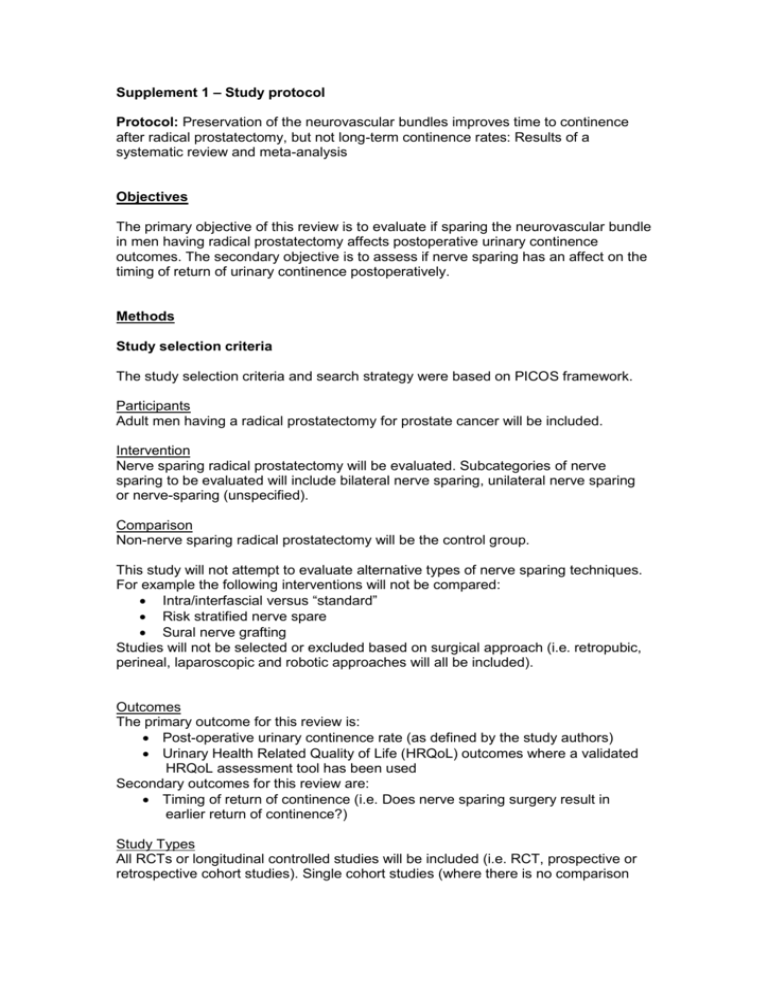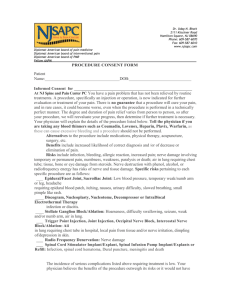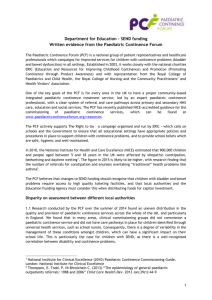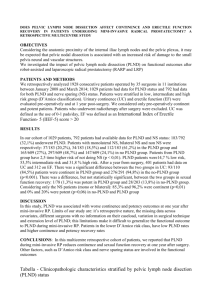file - European Urology
advertisement

Supplement 1 – Study protocol Protocol: Preservation of the neurovascular bundles improves time to continence after radical prostatectomy, but not long-term continence rates: Results of a systematic review and meta-analysis Objectives The primary objective of this review is to evaluate if sparing the neurovascular bundle in men having radical prostatectomy affects postoperative urinary continence outcomes. The secondary objective is to assess if nerve sparing has an affect on the timing of return of urinary continence postoperatively. Methods Study selection criteria The study selection criteria and search strategy were based on PICOS framework. Participants Adult men having a radical prostatectomy for prostate cancer will be included. Intervention Nerve sparing radical prostatectomy will be evaluated. Subcategories of nerve sparing to be evaluated will include bilateral nerve sparing, unilateral nerve sparing or nerve-sparing (unspecified). Comparison Non-nerve sparing radical prostatectomy will be the control group. This study will not attempt to evaluate alternative types of nerve sparing techniques. For example the following interventions will not be compared: Intra/interfascial versus “standard” Risk stratified nerve spare Sural nerve grafting Studies will not be selected or excluded based on surgical approach (i.e. retropubic, perineal, laparoscopic and robotic approaches will all be included). Outcomes The primary outcome for this review is: Post-operative urinary continence rate (as defined by the study authors) Urinary Health Related Quality of Life (HRQoL) outcomes where a validated HRQoL assessment tool has been used Secondary outcomes for this review are: Timing of return of continence (i.e. Does nerve sparing surgery result in earlier return of continence?) Study Types All RCTs or longitudinal controlled studies will be included (i.e. RCT, prospective or retrospective cohort studies). Single cohort studies (where there is no comparison group described), case-control studies and cross-sectional studies will not be included. Search Strategy The search will be run in the following electronic databases: PubMed Medline Cochrane Central Register of Controlled Trials Results will be restricted to publications from 1982 onwards, given that nerve sparing surgery was not described prior to this time. Studies in languages other than English will not be included. Results will not be restricted by publication status. Current and ongoing trials will be searched for using the following website: www.clinicaltrials.gov The reference lists from included publications and relevant reviews will be hand searched to identify further potentially relevant studies. Selection of studies Records identified will be collated and de-duplicated. Two authors will independently screen search results. The full text of any potentially relevant studies will be reviewed and studies selected based on the pre-determined inclusion criteria. If discrepancies are not able to be resolved through discussion, a third author will be consulted. Data extraction and management Two authors will develop and pilot a standardized data collection form and independently undertake data extraction for all studies. The following data will be extracted for included studies: Study details: reference details, country, year, contact details, funding source, conflicts of interest Methods: study design, duration, location, clinical setting, risk of bias Participants: sample size, inclusion and exclusion criteria, baseline characteristics (age, cancer characteristics, BMI, preop continence), surgical approach Intervention: description of nerve sparing status, comparison group(s) and method for classification Outcomes: continence (definition), urinary related HRQoL outcomes (assessment tool), diagnostic assessment, timing of method of outcome measurement Results: summary data for each intervention group, information on subgroups, statistical methods used References to other potentially relevant publications Assessment of risk of bias of selected studies Risk of bias for each study will be assessed independently by two authors using predefined criteria (Table 1). Risk of bias for each element will be described as high, low or unclear. Table 1 Items to assess risk of bias for different study designs Study design Item RCT Sequence generation (Adapted from [1]) Allocation concealment Blinding Incomplete outcome data Selective outcome reporting Other sources of bias Cohort Study Study design (prospective/retrospective) (Adapted from [2]) Cohorts drawn from same population Assessment of nerve spare Outcome of interest not present at start of study Comparability of groups (baseline; co-interventions) Assessment of outcome Adequate follow-up of cohorts (number lost to follow-up) Measures of treatment effect Risk ratio (with 95% confidence interval) will be calculated for dichotomous variables (continence rates). Mean difference (with 95% CI) will be calculated for continuous variables (HRQoL outcomes) where the same scale has been used. Dealing with missing data Where there is missing data from included RCTs we will attempt to contact authors. Where there is missing data from cohort studies, authors will not be contacted. If there is insufficient data for meta-analysis these studies will be excluded. Where continence rates are reported as proportions (i.e. percentages) these will be used to calculate estimated number of continent participants. Assessment of heterogeneity Similarity of individual studies will be assessed with respect to clinical and methodological diversity. The following factors will be considered: Baseline characteristics of participants o e.g. pre-operative continence rate, age, other treatments received (such as radiotherpy) Type of intervention o Surgical approach o Author definition/assessment of nerve sparing status Statistical heterogeneity will be assessed using Chi square analysis and I2 statistic. Data synthesis Studies will be grouped according to intervention, comparison and outcomes evaluated (including timing of outcome reporting). If studies are judged to be sufficiently similar, meta-analysis will be performed to pool results. A random effects model will be used to establish a pooled risk ratio. A sensitivity analysis will be undertaken, evaluating studies of the highest available evidence. Statistic analyses will be done using Review Manager software v5.2 (Copenhagen: The Nordic Cochrane Centre, The Cochrane Collaboration, 2012). Should a meta-analysis not be possible due to study heterogeneity, we will present results of individual studies and undertake a narrative synthesis. Subgroup analyses The following subgroup analysis will be performed if sufficient data is available: Timing of outcome measurement References 1. Higgins JPT, Green S (editors). Cochrane Handbook for Systematic Reviews of Interventions Version 5.1.0 [updated March 2011]. The Cochrane Collaboration, 2011. Available from www.cochrane-handbook.org 2. The Cochrane Collaboration. Tool to Assess Risk of Bias in Cohort Studies. http://bmg.cochrane.org/sites/bmg.cochrane.org/files/uploads/Tool%20to%20 Assess%20Risk%20of%20Bias%20in%20Cohort%20Studies.pdf (Accessed 2014)







